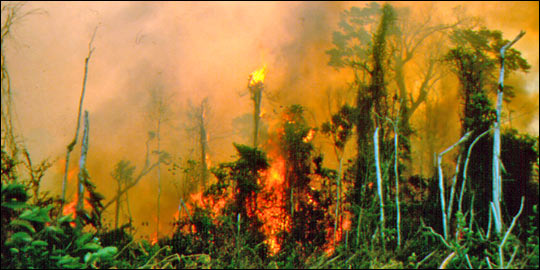Forest fires increasingly dominate Amazonian carbon emissions during droughts

Carbon emissions from the Brazilian Amazon are increasingly dominated by forest fires during extreme droughts rather than by emissions from fires directly associated with the deforestation process, according to a study in Nature Communications.
The authors suggest that recurrent 21st century droughts may undermine achievements in reducing emissions from deforestation in this region.
Lead author Luiz Aragão (National Institute for Space Research, Brazil) and colleagues, including Prof Manuel Gloor and Prof Oliver Phillips from the Priestley International Centre for Climate at the University of Leeds, used satellite data and greenhouse gas inventories to assess drought impacts on fire incidence and associated carbon emissions between 2003 and 2015 in the Brazilian Amazon.
The authors found that, despite a 76% decline in deforestation rates over the past 13 years, fire incidence increased by 36% during the 2015 drought compared to the preceding 12 years.
They estimate that forest fires during drought years alone contribute an average of one billion tonnes of CO2 emissions annually to the atmosphere - which is more than half those from old-growth forest deforestation.
This the first time that scientists have clearly demonstrated how forest fires can become widely spread during recent droughts and how much they influence Amazonian carbon emissions in a decadal scale.
Lessons learned with this study are important because some observations and models indicate that the intensity and frequency of droughts in Amazonia may increase as a consequence of climate change and deforestation.
The authors argue that ongoing pervasive land-use activities and the intensification of extreme droughts are likely to increase fire emissions unrelated to the deforestation, risking the stability of forest carbon stocks and undermining the biodiversity co-benefits achievable in carbon conservation schemes, such as reducing emissions from deforestation and forest degradation (REDD+).
Image: Woods Hole Research Center
The paper has also been covered by Carbon Brief
